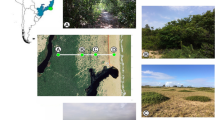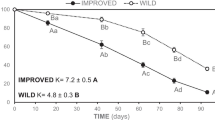Abstract
The decomposition of leaf litter is a key ecological process in stream ecosystems. Leaf traits, variable across species and within species, constitute a prime driver of this process. Vitis vinifera, the most valuable horticultural crop in the world, represent a priviledged opportunity to assess the importance of intra-specific leaf variability on litter decomposition due to its high phenotypical diversity across cultivars. This study aims to assess the importance of leaf trait differences of four Vitis vinifera cultivars (Aragonez, Baga, Bical and Fernão Pires) on mass loss and microbial and detritivore descriptors, in a low order stream. Results indicate that leaf trait variability among cultivars is a main driver of leaf mass loss and microbial decomposers activity. Fungal sporulation rates were reduced in leaves from cultivars more defended by structural defenses—thoughness, higher leaf mass per area and trichomes density. Invertebrates’ structure and density of shredders responded to leaf N concentrations more than leaf structural descriptors. Macroinvertebrates seem to play a crucial role as decomposition facilitators, by accelerating fungal colonization and conidial release, particularly in cultivars endowed with a dense indumentum. Our results indicate that V. vinifera leaf litter is a high-quality substratum that may present narrow intra-specific leaf traits variability, determined by distinct cultivar genetics, which are able to modulate the litter decomposition process in streams. We suggest that further research assessing the effects of vegetation alterations on stream ecosystem functioning should include leaf litter intra-specific dissimilarities that, even when subtle, may propagate from terrestrial to aquatic systems with cascading impacts across the stream food chains.



Similar content being viewed by others
Data availability
The authors are pleasured to share the data after formal request.
Code availability (software application or custom code)
Not applicable.
References
Albert CH, Thuiller W, Yoccoz NG et al (2010) A multi-trait approach reveals the structure and the relative importance of intra-vs. interspecific variability in plant traits. Funct Ecol 24:1192–1201
APHA (2005) Standard methods for the examination of water and wastewater
Arroita M, Flores L, Larrañaga A et al (2017) Water abstraction impacts stream ecosystem functioning via wetted-channel contraction. Freshw Biol. https://doi.org/10.1111/fwb.12864
Bärlocher F, Kebede YK, Gonçalves AL, Canhoto C (2013) Incubation temperature and substrate quality modulate sporulation by aquatic hyphomycetes. Microb Ecol 66:30–39
Battin TJ, Luyssaert S, Kaplan LA et al (2009) The boundless carbon cycle. Nat Geosci 2:598–600
Bessis R (2007) Evolution of the grapevine (Vitis vinifera L.) imprinted by natural and human factors. Botany 85:679–690
Canhoto C, Graca MAS (1996) Decomposition of Eucalyptus globulus leaves and three native leaf species (Alnus glutinosa, Castanea sativa and Quercus faginea) in a Portuguese low order stream. Hydrobiologia 333:79–85
Canhoto C, Graça MAS (1999) Leaf barriers to fungal colonization and shredders (Tipula lateralis) consumption of decomposing Eucalyptus globulus. Microb Ecol 37:163–172
Casas JJ, Larrañaga A, Menéndez M et al (2013) Leaf litter decomposition of native and introduced tree species of contrasting quality in headwater streams: How does the regional setting matter? Sci Total Environ 458:197–208
Castro-Díez P, Puyravaud J-P, Cornelissen JHC (2000) Leaf structure and anatomy as related to leaf mass per area variation in seedlings of a wide range of woody plant species and types. Oecologia 124:476–486
Cebrian J (1999) Patterns in the fate of production in plant communities. Am Nat 154:449–468
Chikwanha OC, Raffrenato E, Muchenje V et al (2018) Varietal differences in nutrient, amino acid and mineral composition and in vitro rumen digestibility of grape (Vitis vinifera) pomace from the Cape Winelands vineyards in South Africa and impact of preservation techniques. Ind Crops Prod 118:30–37
Compson ZG, Hungate BA, Whitham TG et al (2018) Linking tree genetics and stream consumers: isotopic tracers elucidate controls on carbon and nitrogen assimilation. Ecology 99:1759–1770
Connolly NM, Pearson RG (2013) Nutrient enrichment of a heterotrophic stream alters leaf litter nutritional quality and shredder physiological condition via the microbial pathway. Hydrobiologia 718:85–92
Cornut J, Ferreira V, Gonçalves AL et al (2015) Fungal alteration of the elemental composition of leaf litter affects shredder feeding activity. Freshw Biol 60:1755–1771
Cornwell WK, Cornelissen JHC, Amatangelo K et al (2008) Plant species traits are the predominant control on litter decomposition rates within biomes worldwide. Ecol Lett 11:1065–1071
Dang CK, Gessner MO, Chauvet E (2007) Influence of conidial traits and leaf structure on attachment success of aquatic hyphomycetes on leaf litter. Mycologia 99:24–32
de la Riva EG, Olmo M, Poorter H et al (2016) Leaf mass per area (LMA) and its relationship with leaf structure and anatomy in 34 Mediterranean woody species along a water availability gradient. PLoS One 11:e0148788
Duarte S, Cássio F, Pascoal C, Bärlocher F (2017) Taxa-area relationship of aquatic fungi on deciduous leaves. PLoS One 12:56
Fernandes I, Pascoal C, Guimaraes H et al (2012) Higher temperature reduces the effects of litter quality on decomposition by aquatic fungi. Freshw Biol 57:2306–2317
García-Palacios P, McKie BG, Handa IT et al (2016) The importance of litter traits and decomposers for litter decomposition: a comparison of aquatic and terrestrial ecosystems within and across biomes. Funct Ecol 30:819–829. https://doi.org/10.1111/1365-2435.12589
Gessner MO, Chauvet E (2002) A case for using litter breakdown to assess functional stream integrity. Ecol Appl 12:498–510
Gessner MO, Chauvet E (1993) Ergosterol-to-biomass conversion factors for aquatic hyphomycetes. Appl Environ Microbiol 59:502–507
Gessner MO, Gulis V, Kuehn KA et al (2007) 17 Fungal decomposers of plant litter in aquatic ecosystems. CP Kubicek 512:301–324
Gonçalves AL, Canhoto C (2009) Decomposition of eucalypt and alder mixtures: responses to variation in evenness. Arch Für Hydrobiol 173:293–303. https://doi.org/10.1127/1863-9135/2009/0173-0293
Gonçalves AL, Chauvet E, Bärlocher F et al (2014) Top-down and bottom-up control of litter decomposers in streams. Freshw Biol 59:2172–2182
Gonçalves AL, Graça MAS, Canhoto C (2013) The effect of temperature on leaf decomposition and diversity of associated aquatic hyphomycetes depends on the substrate. Fungal Ecol 6:546–553
Graça MAS, Bärlocher F, Gessner M (2005) Methods to study litter decomposition. Springer, Dordrecht
Graça MAS, Cressa C, Gessner MO et al (2001) Food quality, feeding preferences, survival and growth of shredders from temperate and tropical streams. Freshw Biol 46:947–957
Hladyz S, Gessner MO, Giller PS et al (2009) Resource quality and stoichiometric constraints on stream ecosystem functioning. Freshw Biol 54:957–970. https://doi.org/10.1111/j.1365-2427.2008.02138.x
Jackrel SL, Morton TC, Wootton JT (2016) Intraspecific leaf chemistry drives locally accelerated ecosystem function in aquatic and terrestrial communities. Ecology 97:2125–2135
Kearns S, Barlocher F (2008) Leaf surface roughness influences colonization success of aquatic hyphomycete conidia. Fungal Ecol 1:13–18. https://doi.org/10.1016/j.funeco.2007.07.001
Kominoski JS, Pringle CM (2009) Resource-consumer diversity: testing the effects of leaf litter species diversity on stream macroinvertebrate communities. Freshw Biol 54:1461–1473. https://doi.org/10.1111/j.1365-2427.2009.02196.x
Lecerf A, Chauvet E (2008) Intraspecific variability in leaf traits strongly affects alder leaf decomposition in a stream. Basic Appl Ecol 9:598–605
LeRoy CJ, Hipp AL, Lueders K et al (2020) Plant phylogenetic history explains in-stream decomposition at a global scale. J Ecol 108:17–35
Leroy CJ, Marks JC (2006) Litter quality, stream characteristics and litter diversity influence decomposition rates and macroinvertebrates. Freshw Biol. https://doi.org/10.1111/j.1365-2427.2006.01512.x
LeRoy CJ, Whitham TG, Wooley SC, Marks JC (2007) Within-species variation in foliar chemistry influences leaf-litter decomposition in a Utah river. J North Am Benthol Soc 26:426–438. https://doi.org/10.1899/06-113.1
LeRoy CJ, Wooley SC, Lindroth RL (2012) Genotype and soil nutrient environment influence aspen litter chemistry and in-stream decomposition. Freshw Sci 31:1244–1253
López-Rojo N, Martínez A, Pérez J et al (2018) Leaf traits drive plant diversity effects on litter decomposition and fpom production in streams. PLoS One. https://doi.org/10.1371/journal.pone.0198243
Marks JC, Haden GA, Harrop BL et al (2009) Genetic and environmental controls of microbial communities on leaf litter in streams. Freshw Biol 54:2616–2627
Martin AR, Rapidel B, Roupsard O et al (2017) Intraspecific trait variation across multiple scales: the leaf economics spectrum in coffee. Funct Ecol 31:604–612
Martínez A, Larrañaga A, Pérez J et al (2013) Leaf-litter quality effects on stream ecosystem functioning: a comparison among five species. Fundam Appl Limnol. https://doi.org/10.1127/1863-9135/2013/0514
Martínez A, Monroy S, Pérez J et al (2016) In-stream litter decomposition along an altitudinal gradient: does substrate quality matter? Hydrobiologia 766:17–28
Moore JC, de Ruiter PC (2012) Energetic food webs: an analysis of real and model ecosystems. OUP Oxford
Moran EV, Hartig F, Bell DM (2016) Intraspecific trait variation across scales: implications for understanding global change responses. Glob Chang Biol 22:137–150
Olmo HP (2003) The origin and domestication of the Vinifera grape. In: The origins and ancient history of wine. Routledge, pp 52–66
Ostrofsky ML (1997) Relationship between chemical characteristics of autumn-shed leaves and aquatic processing rates. J North Am Benthol Soc 16:750–759
Pantelić MM, Zagorac DČD, Ćirić IŽ et al (2017) Phenolic profiles, antioxidant activity and minerals in leaves of different grapevine varieties grown in Serbia. J Food Compos Anal 62:76–83
Pérez J, Martínez A, Descals E, Pozo J (2018) Responses of aquatic hyphomycetes to temperature and nutrient availability: a cross-transplantation experiment. Microb Ecol 76:328–339
Polis GA, Strong DR (1996) Food web complexity and community dynamics. Am Nat 147:813–846
R Development Core Team (2016) R: A language and environment for statistical computing. R Foundation for Statistical Computing, Vienna
Raymond PA, Hartmann J, Lauerwald R et al (2013) Global carbon dioxide emissions from inland waters. Nature 503:355–359
Reis F, Nascimento E, Castro H et al (2018) Land management impacts on the feeding preferences of the woodlouse Porcellio dilatatus (Isopoda: Oniscidea) via changes in plant litter quality. Appl Soil Ecol 132:45–52
Rustioni L, Cola G, Maghradze D et al (2019) Description of the Vitis vinifera L. phenotypic variability in eno-carpological traits by a Euro-Asiatic collaborative network among ampelographic collections. Vitis-J Grapevine Res 58:37–46
Schweitzer JA, Bailey JK, Rehill BJ et al (2004) Genetically based trait in a dominant tree affects ecosystem processes. Ecol Lett 7:127–134
Siefert A, Violle C, Chalmandrier L et al (2015) A global meta-analysis of the relative extent of intraspecific trait variation in plant communities. Ecol Lett 18:1406–1419
Stelzer RS, Heffernan J, Likens GE (2003) The influence of dissolved nutrients and particulate organic matter quality on microbial respiration and biomass in a forest stream. Freshw Biol 48:1925–1937
Sterner RW, Elser JJ (2002) Ecological stoichiometry: the biology of elements from molecules to the biosphere. Princeton University Press, Princeton
Tachet H, Richoux P, Bournaud M, Usseglio-Polatera F (2002) Invertébrés d’eau douce. Systematique, biologie, écologie. Paris, France
Tank JL, Rosi-Marshall EJ, Griffiths NA et al (2010) A review of allochthonous organic matter dynamics and metabolism in streams. J North Am Benthol Soc 29:118–146
Wallace JB, Eggert SL, Meyer JL, Webster JR (1997) Multiple trophic levels of a forest stream linked to terrestrial litter inputs. Science (80-) 277:102–104
Willer H, Lernoud J (2019) The world of organic agriculture. Statistics and emerging trends 2019. Research Institute of Organic Agriculture FiBL and IFOAM Organics International
Woodward G (2009) Biodiversity, ecosystem functioning and food webs in fresh waters: assembling the jigsaw puzzle. Freshw Biol 54:2171–2187
Young JC (1995) Microwave-assisted extraction of the fungal metabolite ergosterol and total fatty acids. J Agric Food Chem 43:2904–2910
Acknowledgements
This work was supported by the R&D Unit Center for Functional Ecology—Science for People and the Planet (CFE), with reference UIDB/04004/2020, financed by FCT/MCTES through national funds (PIDDAC), and by project ReNATURE—Valorization of the Natural Endogenous Resources of the Centro Region (Centro 2020, Centro-01-0145-FEDER-000007), which also supported AM (fellowship reference ReNATURE–BPD11_2).
Author information
Authors and Affiliations
Contributions
Experimental design: RO, ALG & CC. Field work: RO. Laboratory work: RO, AM & ALG. Data analyses: RO & AM. Writing: RO, AM, ALG & CC.
Corresponding author
Ethics declarations
Conflict of interest
The authors declare no conflicts of interest/competing interests.
Consent to participate
The authors consent to participate in peer review process.
Consent for publication
The authors consent for publication in the terms of the journal.
Ethical approval
Not applicable.
Additional information
Publisher's Note
Springer Nature remains neutral with regard to jurisdictional claims in published maps and institutional affiliations.
Handling Editor: Télesphore Sime-Ngando.
Rights and permissions
About this article
Cite this article
Oliveira, R., Martínez, A., Gonçalves, A.L. et al. Intra-specific leaf trait variability controls leaf decomposition of Vitis vinifera L. cultivars in streams. Aquat Ecol 56, 47–57 (2022). https://doi.org/10.1007/s10452-021-09891-0
Received:
Accepted:
Published:
Issue Date:
DOI: https://doi.org/10.1007/s10452-021-09891-0




